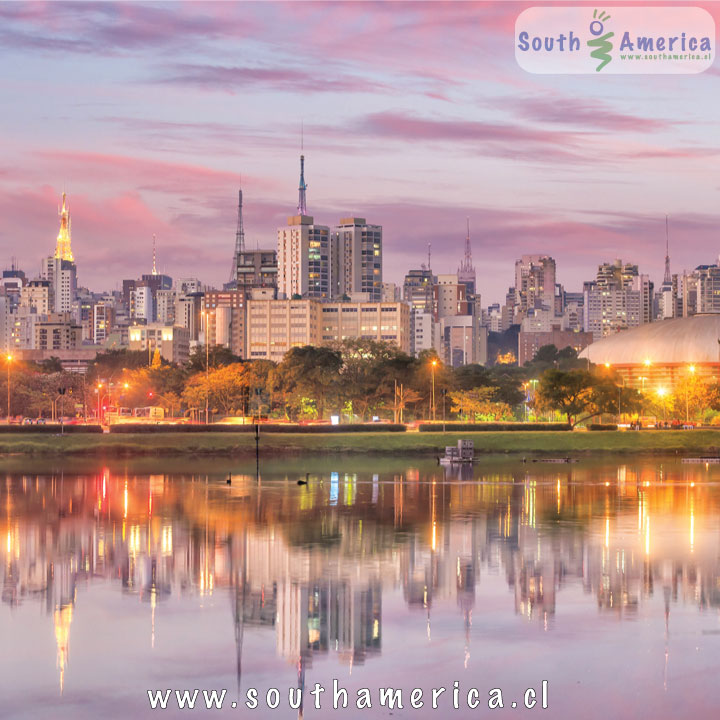Sao Paulo
Brazil

Sao Paulo is an immense city of over 17 million people making it the largest in South America. Interestingly, Sao Paulo has the largest Japanese community outside of Japan with over a million Japanese who are either direct or indirect descendents.
Avenida Paulista (Avenue)
Sao Paulo is one of the most important financial centers of Latin America with the main avenue (Avenida Paulista) lined with banks, corporations and other financial institutions.
Every Sunday from 9am to 2pm on the stretch of Paulista Avenue between Alameda Casa Branca and Rua Pamplona you will find recreational and artistic activities where everyone can enjoy various types of entertainment for free.
Catedral da Sé - Sao Paulo's main cathedral.
Personal Experience (Rob W.)
Sao Paulo is a HUGE city. Traffic is horrendous and sometimes you feel that you can get to a place faster by walking there. The traffic doesn't seem to stop even in the early hours of the morning. We heard a lot of stories about how unsafe Sao Paulo can be though we didn't really feel that until we visited the center of the city and its cathedral (Catedral da Sé). You need to have your wits about you and use typical traveler's common sense of not having your camera (and jewelry) noticeably seen. If you want to eat cheaply, visit the numerous places that sell food by the kilo. It's like a smorgasbord where you pile whatever you fancy onto your plate which is then weighed to see how much it costs.
Gastronomy
If gastronomy is one of Sao Paulo's main attractions, then the Paulista region is privileged, catering to all tastes. Visitors can experiment sophisticated works of food-art or the traditional Brazilian cuisine, along with French, Portuguese, Italian and Japanese styles to choose from. Rua Haddock Lobo, Bela Ceintra and Alameda Santos (different streets) are true temples of flavors. For those that prefer more popular places, the region of Bixiga contains several cantinas and pizzerias in the most traditional Italian style.
Replete with entertainment, the districts of Vila Olímpica, Itaim and Moema are also an excellent option for those that admire good cooking, with an immense variety of cuisines. Rua Amauri and the surrounding streets can be considered gastronomic shop windows. There are two famous establishments on Rua Joaquim Floriano where visitors can consume tasty sandwiches at the late hours of the night. The region also has a church that many inhabitants (paulistanos) consider the most impressive in the city: lgreja Nossa Senhora do Brasil (Praca Nossa Senhora do Brasil, 1 - on the corner of Avenida Brasil and Rua Colômbia).
Pretty much any restaurant in Vila Madalena will offer excellent Brazilian food.
Check out some typical Brazilian Food and Drink.
Culture and Art
The region has a large amount of culture centers, and spaces, such as Itaú Cultural, a wide variety of movie theaters, with emphasis on Cine Belas Artes. The theater has its temple reserved in the region of Bixiga, which figures 9 important buildings, with an evidence on Teatro Abril, occupying the place of the old CineTeatro Paramount (1929), which in the 60's hosted the famous musical festivals of TV Record. The facade and the lobby, in the art noveau style, were listed a protected historical site.
For those that appreciate handicraft, it is worth paying a visit to the Art, Handicraft and Culture Fair located in Praca Nossa Senhora Aparecida square (on the corner of Avenida Ibirapuera and Avenida Moema) on Saturdays and Sundays (from 9.00am to 5.00pm). The region sports highly diversified culture and entertainment options. There are lots of concert halls and movie theaters. You can visit three museums in the region of Jardins: MIS - Museu de Imagem e do Som, (Avenida Euripa 158), MUBE - Museu Brasileiro da Escultura, (Rua Alemanha, 221) and Museu da Casa Brasileira, (Avenida Brigadeiro Faria Lima, 2705). The latter has a collection of crystals, furniture and objects from the 16th century. In Vila Olimpia, it is worthwhile getting to know the nightlife in the triangular area formed by Avenida Juscelino Kubitscheck, Rua Gomes de Carvalho and Rua Atílio Inocenti, where several bars and discos are concentrated.
Shopping
For those that love shopping and looking for bargains, then the districts of Vila Olímpica, Itaim and Moema are an excellent option. These areas have important shopping malls, concert halls, various restaurants and cultural centers. Besides the shopping malls, another tip is to walk along Rua Joáo Cachoeira and its surrounding areas, where you can find shoes, clothing and toys at excellent prices.
Parque Ibirapuera
Nature lovers can take a walk through Parque Ibirapuera, the largest park in the city. Take some time to enjoy the immense area with its culture and leisure equipment, such as Paviháo Cicillo Matarazza Sobrinho, where trade fairs and exhibitions are held. You can also visit MAC - Museu de Arte Comtemporánea, and MAM - Museu de Arte Moderna, or Modern Art Museum (entrance by gate 3). Take advantage of the contact with nature and go for a long walk. To end your tour, watch the light show of the 450th Anniversary Fountain, a unique spectacle. If you have children it is worthwhile visiting Casa dos Sonhos da Estrela which has a toy museum, (close to the park at Av. República do Líbano 501).
Art, Culture and Nightlife
Art, good gastronomy and entertainment are characteristics of the region on Pinheiros and Vila Madalena, which concentrates excellent discos, coffee shops, art galleries, restaurants and bars. The region is a good option for a nightlife, although strolls can begin in the morning, following a shopping itinerary on streets with specialized trade figuring antiques, second hand furniture and joineries. This is the profile of Rua Cardeal Arco Verde and Rua Teodoro Sampaio, - which is also a reference for musical instruments, - both located in the district Pinheiros; and Rua Aspicuelta and Rua Harmonia in Vila Madalena, where visitors can find everything about design and objects for home decoration.
With a strong cultural appeal, the region also houses a wide variety of art galleries, cultural centers and bookstores. A main attraction is Feira de Artes da Praca Benedito Calixto, an Art Fair that is a traditional meeting point of tourists, which takes place on Saturdays from 9.00am to 6.00pm. Feria da Vila, is held in August, with hundreds of stalls selling handicrafts. Check out the permanent exhibitions at Instituto Cultural Tomie Ohtake (Rua Coropés, 88 - Pinheiros, phone: 6844-1900) and Instituto Goethe (Rua Lisboa, 974 - Pinheiros phone: 3088-4288).
In the district of Vila Madalena, an interesting option is to take a walk through the streets, allies and lanes, where you will find countless art galleries and stores, from massage clinics to joineries, also including decoration, clothing and handicraft centers.
Bars and Restaurants
The nightlife in Vila Madalena is concentrated in the bars located on Fidalga, Aspicuelta, Girassol, Morato Coelho, Fradique Coutinho, Delfina, Wizard, Orginal and Inácio Pereira da Rocha streets. In Pinheiros, Avenida Henrique Schaumman, Avenida Brigadeiro Faria Lima, Rua Pedroso de Morais, Cardeal Arco Verde, Cristiano Viana and Pinheiros are also known for their variety of bars for nightly entertainment. The region also has several kinds of cuisine, with emphasis on Argentine, Italian, Chinese, Spanish, Brazilian and Portuguese cooking. After enjoying a delicious meal, try out the delicacies offered by the famous sweet shops from the district.
Exhibitions, adventure, romanticism and emotion
Sao Paulo is the Latin American capital of business tourism and the district of Santana contains the largest exhibition center in Latin America: Pavilháo e Convencóes da Anhemi Turismo e Eventos da Cidade de Sáo Paulo (Av. Olavo Fontoura, 1209). Parque Anhembi, as it is known, holds a large quantity of the most important fairs held in the country. The area underwent a revitalization process involving enlargement and improvement. Part of this project corresponded to the opening in 2004 of Hotel Holiday Inn Parque Anhemi, the largest hotel in terms of accommodation, in Latin America with 780 rooms.
Receiving a considerable portion of the business events that take place in the city every year, the region also houses another important building: Expo Center Norte (Rua Jose Bernardino Pinto, 333, Vila Guilherme).
But Santana, Freguesia do Ó and Cantareira do not only live off events. This region is a growing complex in terms of gastronomy, nightlife and abundant green areas. It has bars, pubs and restaurants catering only to business travelers but also the young public. There are also countless stores, art galleries and antique stores.
On Av. Luis Dumont Villares, in Santana, traditionally known for its busy nightlife, visitors can enjoy themselves for hours in its various bars and nightclubs in a wide variety of styles. Av. Bras Leme, with its traditional fast-food places, bars and restaurants is undoubtedly a meeting point for generations that appreciate it gastronomical variety, which ranges from a quick snack through to typical Italian and Japanese cuisine.
In the district of Freguesia do Ó - Largo da Matciz, a small square in provincial style, the bohemian part of the North Side, visitors can find bars and botecos (public bars), with the noteworthy hospitality their owners.
If you found this guide about Sao Paulo, Brazil interesting or useful, let others know about it.

